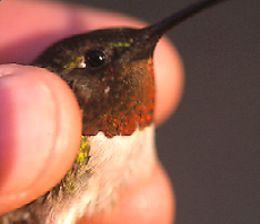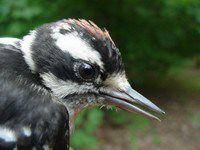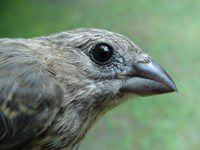|
"Birds Do It. Bees Do It. Even Educated Fleas Do It."
When songwriter Cole Porter penned his memorable lyrics about everything from birds and bees to electric eels and Cape Cod clams, he was talking about "falling in love." It's debatable whether any of these organisms experience love as an emotion, but they--and we humans--all have ways of "doing it" that allow the passing of genes from one generation to the next.
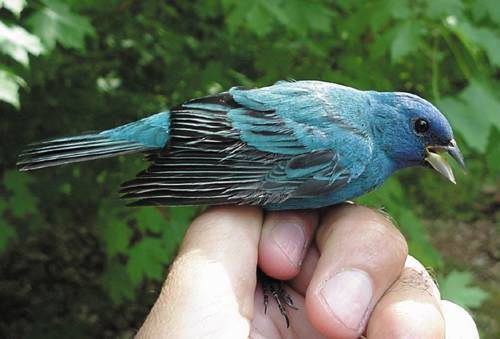
All photos & text © Hilton Pond Center
Here at Hilton Pond Center, we've been fortunate to observe some of the amazing sexual adaptations that occur in plants and animals. Birds--such as the male Indigo Bunting above--have distinctive reproductive behaviors and morphologies that tie directly with the rest of their lifestyles. But unlike many animals, a bird faces the very real problem of staying light enough to fly while still being able to reproduce.
One way female birds accomplish aerodynamic lightness is to lay eggs in a nest rather than carrying young inside as mammals do. In addition, almost all female birds have only one functioning ovary; usually the one on the right is permanently vestigial. This makes one less organ to lift off the ground during flight, and even the left ovary shrinks considerably in the off-season. Male birds have a similar weight-saving reproductive adaptation; their testes are tiny and dormant for most of the year but may swell to 200-300 times normal size during the peak of the breeding season. In fact, the testes in a reproductively active duck may comprise ten percent of its total body weight! With all those extra hormones raging in spring, it's no wonder Northern Cardinal males attack their reflections in automobile hubcaps or virile Northern Mockingbirds sing all night long.
Male birds face another reproductive conundrum. Unlike most mammals--in which testes are external and suspended away from the body in a somewhat cooler environment--a bird's testes are deep within his "hot" body. 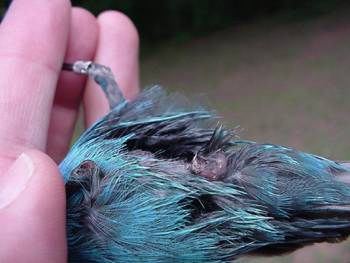 On one hand, this is fortunate because it presents a streamlined flight profile, but it also creates a critical situation: sperm usually fail to develop or die if heated just a few degrees above the optimum. Because birds have warmer bodies than most mammals--usually about 105º F or so--their sperm are at even greater risk. Many male birds get around this problem by developing a swollen area around the cloacal opening where sperm are temporarily stored and where temperatures may as much as 7º F cooler. This "cloacal protuberance" contains part of the vas deferens, where "cool" mature sperm lie ready to do their duty. Some songbirds (including the Indigo Bunting, above left) develop such noticeable protuberances that a bander can quickly determine the sex even for species in which males and females are otherwise similar in appearance. On one hand, this is fortunate because it presents a streamlined flight profile, but it also creates a critical situation: sperm usually fail to develop or die if heated just a few degrees above the optimum. Because birds have warmer bodies than most mammals--usually about 105º F or so--their sperm are at even greater risk. Many male birds get around this problem by developing a swollen area around the cloacal opening where sperm are temporarily stored and where temperatures may as much as 7º F cooler. This "cloacal protuberance" contains part of the vas deferens, where "cool" mature sperm lie ready to do their duty. Some songbirds (including the Indigo Bunting, above left) develop such noticeable protuberances that a bander can quickly determine the sex even for species in which males and females are otherwise similar in appearance.
One other male adaptation: Most birds have no intromittent organ. 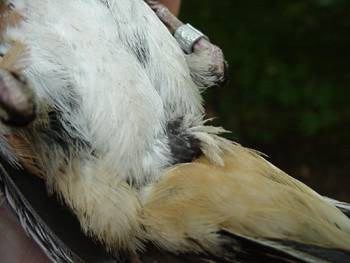 Instead, sperm are transferred when the male touches his swollen cloaca briefly to that of a receptive female--a lightning-fast process known somewhat indelicately as the "cloacal kiss." Upon release, sperm are further guided in many birds (such as the male Eastern Towhee, above right) by a ring of feathers around the tip of the male's cloaca. Instead, sperm are transferred when the male touches his swollen cloaca briefly to that of a receptive female--a lightning-fast process known somewhat indelicately as the "cloacal kiss." Upon release, sperm are further guided in many birds (such as the male Eastern Towhee, above right) by a ring of feathers around the tip of the male's cloaca.
Female birds also undergo external physical changes during the breeding season. Especially noticeable on a bird in-the-hand is an "incubation patch" or "brood patch"--an area of bare skin on the bird's belly (see American Robin, below left). 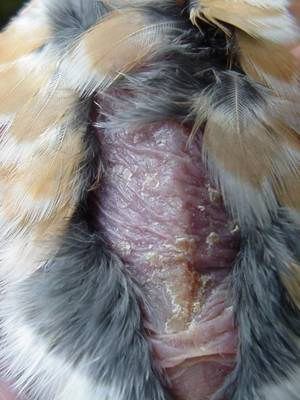 Normally, this region is nearly covered by down feathers, which either fall out or are plucked by the female as she begins incubating. Feathers are great insulators, of course, so when they're absent from her belly the female is much better able to transmit body heat to her developing eggs. Even more amazingly, the brood patch also becomes highly vascularized (filled with blood vessels that carry more heat to eggs or chicks), AND it becomes edematous (fluid collects beneath the skin, turning the patch into what amounts to a very efficient hot water bottle). Again, in many sexually monomorphic species, a breeding female in-the-hand can be identified by her patch, but some male birds (e.g., woodpeckers) also may develop modified incubation patches. Normally, this region is nearly covered by down feathers, which either fall out or are plucked by the female as she begins incubating. Feathers are great insulators, of course, so when they're absent from her belly the female is much better able to transmit body heat to her developing eggs. Even more amazingly, the brood patch also becomes highly vascularized (filled with blood vessels that carry more heat to eggs or chicks), AND it becomes edematous (fluid collects beneath the skin, turning the patch into what amounts to a very efficient hot water bottle). Again, in many sexually monomorphic species, a breeding female in-the-hand can be identified by her patch, but some male birds (e.g., woodpeckers) also may develop modified incubation patches.
Indeed, these ARE amazing reproductive adaptations. To further quote Cole Porter, "Romantic sponges do it . . . lazy jellyfish do it . . . even goldfish in the privacy of bowls do it . . ." but none of them "do it" quite the way birds "do it" in the Carolina Piedmont and at Hilton Pond Center.
All photos & text © Hilton Pond Center
If you enjoy "This Week at Hilton Pond," please help Support
Hilton Pond Center for
Piedmont Natural History
|

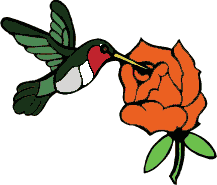 DON'T MISS
DON'T MISS
 On one hand, this is fortunate because it presents a streamlined flight profile, but it also creates a critical situation: sperm usually fail to develop or die if heated just a few degrees above the optimum. Because birds have warmer bodies than most mammals--usually about 105º F or so--their sperm are at even greater risk. Many male birds get around this problem by developing a swollen area around the cloacal opening where sperm are temporarily stored and where temperatures may as much as 7º F cooler. This "cloacal protuberance" contains part of the vas deferens, where "cool" mature sperm lie ready to do their duty. Some songbirds (including the Indigo Bunting, above left) develop such noticeable protuberances that a bander can quickly determine the sex even for species in which males and females are otherwise similar in appearance.
On one hand, this is fortunate because it presents a streamlined flight profile, but it also creates a critical situation: sperm usually fail to develop or die if heated just a few degrees above the optimum. Because birds have warmer bodies than most mammals--usually about 105º F or so--their sperm are at even greater risk. Many male birds get around this problem by developing a swollen area around the cloacal opening where sperm are temporarily stored and where temperatures may as much as 7º F cooler. This "cloacal protuberance" contains part of the vas deferens, where "cool" mature sperm lie ready to do their duty. Some songbirds (including the Indigo Bunting, above left) develop such noticeable protuberances that a bander can quickly determine the sex even for species in which males and females are otherwise similar in appearance. Instead, sperm are transferred when the male touches his swollen cloaca briefly to that of a receptive female--a lightning-fast process known somewhat indelicately as the "cloacal kiss." Upon release, sperm are further guided in many birds (such as the male Eastern Towhee, above right) by a ring of feathers around the tip of the male's cloaca.
Instead, sperm are transferred when the male touches his swollen cloaca briefly to that of a receptive female--a lightning-fast process known somewhat indelicately as the "cloacal kiss." Upon release, sperm are further guided in many birds (such as the male Eastern Towhee, above right) by a ring of feathers around the tip of the male's cloaca. Normally, this region is nearly covered by down feathers, which either fall out or are plucked by the female as she begins incubating. Feathers are great insulators, of course, so when they're absent from her belly the female is much better able to transmit body heat to her developing eggs. Even more amazingly, the brood patch also becomes highly vascularized (filled with blood vessels that carry more heat to eggs or chicks), AND it becomes edematous (fluid collects beneath the skin, turning the patch into what amounts to a very efficient hot water bottle). Again, in many sexually monomorphic species, a breeding female in-the-hand can be identified by her patch, but some male birds (e.g., woodpeckers) also may develop modified incubation patches.
Normally, this region is nearly covered by down feathers, which either fall out or are plucked by the female as she begins incubating. Feathers are great insulators, of course, so when they're absent from her belly the female is much better able to transmit body heat to her developing eggs. Even more amazingly, the brood patch also becomes highly vascularized (filled with blood vessels that carry more heat to eggs or chicks), AND it becomes edematous (fluid collects beneath the skin, turning the patch into what amounts to a very efficient hot water bottle). Again, in many sexually monomorphic species, a breeding female in-the-hand can be identified by her patch, but some male birds (e.g., woodpeckers) also may develop modified incubation patches.
